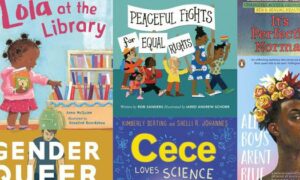
For all the convenience of screens, childhood reading is not merely about decoding words; it is a full-body, social and emotional practice. The feel of paper, the weight of a page turned, the margin where a child can circle a word or jot down a thought – these material cues quietly help sustain attention and memory. Increasingly, research shows that the tactile nature of print continues to play a distinctive role in helping young readers become more compassionate.
Across many studies comparing reading on paper with reading on screens, readers tend to comprehend slightly better from print, particularly when dealing with factual texts or working under time pressure – common features of schoolwork. A meta-analysis found a consistent paper advantage in comprehension, especially for informational texts and timed reading tasks.
Part of the reason is spatial and tactile. A paper book offers fixed landmarks, the thickness of pages read and those yet to come, and the exact placement of a paragraph, which aids orientation and memory. These stable cues are harder to reproduce on scrolling screens and have been linked to deeper concentration and better monitoring of one’s own understanding.
Large-scale assessments such as PISA have also flagged that over-reliance on digital reading may be linked to dips in comprehension, reinforcing the importance of maintaining a balance that keeps print central for deep learning.
Tactile reading invites dialogue
Children rarely read in isolation; they read with parents, grandparents, teachers and friends. The medium shapes the quality of those shared moments. Observational research has found that when adults and young children share print books, there is more back-and-forth conversation about the story and more collaborative exploration than when they read e-books. Those open-ended exchanges – “Why do you think she’s sad?”, for example – are the foundation of inquisitiveness and deeper inference-making.
This pattern is echoed in India: a study of urban Indian families found that many parents were unfamiliar with shared storybook reading and often relied on oral /digital storytelling, suggesting that the shift to dialogic print reading is still emerging in many households.
This does not render digital reading undesirable. Many well-designed e-books are excellent. Yet the physical book naturally draws focus to the story and the relationship, not the device, and encourages dialogue, which is essential to comprehension and empathy.
Empathy cannot be drilled by instruction alone; it is nurtured through practice in perspective-taking. Experiments suggest that even short exposure to nuanced literary fiction can sharpen our ability to recognise others’ feelings and intentions more effectively than exposure to formulaic stories or informational text. Print’s slower, less distracting pace supports the reflective engagement that such stories often require, giving young readers room to inhabit a character’s thoughts and emotions.
Hands, pencils and margins: the tactile loop
Tactility is not confined to turning pages. Writing by hand – underlining, annotating, sketching – engages sensorimotor pathways that help the brain encode symbols and ideas. Studies in early literacy show that learning letters by forming them by hand strengthens neural connections that support later reading. Among older students, longhand note-taking often leads to stronger conceptual understanding than typing, partly because handwriting slows us down and encourages active processing.
For classrooms and families, this insight translates into simple, physical habits: margin notes in pencil, sticky-note questions, story maps drawn on paper – all of which keep curiosity active and visible. Evidence from a parent-mediated shared reading intervention in India shows that guided print-based reading at home significantly boosted young children’s narrative skills, underlining how tactile, interactive reading can support both language and comprehension.
Although digital access has expanded, the presence of physical books at home remains uneven. For many children, particularly in disadvantaged settings, the opportunity to own and handle books is still limited, yet strongly linked with how much they read and how deeply they engage. Ensuring that all children can access print is therefore as much a matter of equity as of pedagogy.
Practical pointers for parents, teachers and libraries
-
Keep print in the mix. Use digital platforms where they add value, such as for research or multimedia, but prioritise print for deep, sustained reading.
-
Make reading tactile. Encourage underlining in personal copies, add sticky-note prompts, and let pupils create their own story maps.
-
Read together in print. Shared print storytime sparks more open-ended talk than most ready-made e-books. Ask questions, wonder aloud, notice feelings.
-
Offer a varied diet. Combine factual texts with literary stories that open windows into other lives, nurturing both knowledge and sensitivity.
Independent publishers like Woodpecker Books have a vital role in keeping print engaging and accessible. Backed by the 69-year heritage of Wilco Publishing, Woodpecker Books has put the book format at the centre of its mission while bringing a fresh wave of content to new generations of readers.
Its lists include premium-quality yet affordable titles, from sturdy board books for small hands to richly illustrated readers that blend real-life images with contemporary artwork. To sustain curiosity, Woodpecker has developed a range of interactive formats – activity books with stickers and puzzles, Learning Treasure Series, Side-and-Learn flash cards, Origami, A–Z alliteration book, and Manga which keep children engaged while building core literacy and thinking skills.
By pairing tradition with innovation, and by collaborating with schools, libraries and reading clubs, publishers like Woodpecker help keep books as living companions that invite touch, talk and discovery.
The point is not to reject digital tools but to remember what paper uniquely offers: a steady, tangible space that anchors attention and sparks dialogue. For children to grow as curious, empathetic readers, they need stories they can hold, flip through, mark and return to. By combining tradition with fresh formats, Woodpecker Books reminds us that books are not just vessels for words but companions that shape how young minds read, imagine, and excel.
Ripal Dixit is a senior editor at Wilco Publishing House.
📰 Crime Today News is proudly sponsored by DRYFRUIT & CO – A Brand by eFabby Global LLC
Design & Developed by Yes Mom Hosting






